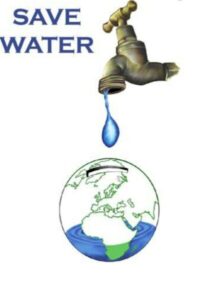National Launch of JALDOOT App: An initiative for Ground Water Depletion and Management

Water is a natural resource that is vital for the existence of life on earth. However, misuse and wastage of water have resulted in a water crisis affecting several parts of the world. Water scarcity is one of the serious concerns for countries across the world. The only solution to avoid this grim situation is to adopt universal methods of water conservation, which could be replicated across households. The government of India supplements the efforts of the States through technical and financial assistance to them through various schemes and programs.
Water conservation initiatives are taken up by the Central Government on a continuous basis and are covered under various schemes and programmes. In order to boost water conservation and rainwater harvesting in the country, the Ministry of Jal Shakti has taken up a nationwide campaign “Jal Shakti Abhiyan – Catch the Rain” (JSA:CTR) with the theme “Catch the rain, where it falls, when it falls” for creating appropriate rainwater harvesting structures in urban and rural areas of all the districts in the country, with people’s active participation, during the pre-monsoon and monsoon periods during 22nd March, 2021 to 30th November, 2021.
On 24thApril 2022, Hon’ble Prime minister launched a mission to conserve water for the future, known as Amrit Sarovar Mission. For celebrating the Azadi Ka Amrit Mahotsav, Amrit Sarovar aims to develop and rejuvenate 75 water bodies in each district of India. Under this mission, 50,000 water bodies of size of about an Acre will be created by 15thAugust 2023. Apart from these two other schemes and programs viz. Mahatma Gandhi National Rural Employment Guarantee Scheme (MGNREGS), Jal Jeevan Mission, Atal Bhujal Yojana, Pradhan Mantri Sinchayee Yojana (PMKSY), Atal Mission for Rejuvenation and Urban Transformation (AMRUT), Mission Namami Gange, Unified Building Bye Laws (UBBL) of Delhi, 2016, Model Building Bye Laws (MBBL), 2016, Urban and Regional Development Plan Formulation and Implementation (URDPFI) Guidelines, 2014 etc. are also being implemented as Water Conservation initiatives.
States/ UTs have been advised to enable Rural Local Bodies/Panchayats to utilise 15th Finance Commissions grants to take up rooftop rainwater harvesting in Government buildings like panchayat, bhawans, anganwadis, Primary Health Centres etc. Government organises workshops, seminars/webinars, awards etc. and encourages people to become active participants for water conservation an drain water harvesting.
Water Harvesting works has been accorded one of the thrust areas of MGNREGS, Ministry of Rural Development. Maximum works which are permissible under Scheme, are related to Natural Resource Management (NRM) which directly or indirectly support water conservation and groundwater recharge. The Scheme has helped in reviving many traditional water bodies. Farm ponds for individuals, Check dams, Trenches, many kinds of plantations, recharge pits, etc. Construction of Dug well is one of the important assets created majorly for individual, community and groups.
As a systematic measurement of the existing depths of groundwater levels on an extensive basis throughout the rural landscape of the country, on27th September, 2022, JALDOOT app was launched by the Ministry of Rural Development which will based across the country to capture and regularly measure the water level of selected 2-3 wells in a village. This will enable groundwater monitoring, water budgeting and planning for water harvesting and conservation-related works.
About
The app will work in both online and offline mode. Water level can be captured even without internet connectivity and captured data will be stored in mobile and when mobile comes in the connectivity area, data will synchronize with the central server. The regular data to be input by the Jaldoots would be integrated with the database of National Water Informatics Centre (NWIC), which can be utilized for analysis and display of various useful reports for the benefit of various stakeholders.
Significance
This app will facilitate observing water tables across the country and the resulting data can be utilized for Gram Panchayat Development Plan and MGNREGS Plans. The app is launched to capture the water level of selected wells in a village across the country twice a year during pre-monsoon and post-monsoon seasons. The app will also ease panchayats with robust information that can be later used for better planning of works.
Status of Groundwater Depletion
According to the Central Ground Water Board (CGWB), with 230 billion meter cubes of groundwater drawn out each year for irrigating agricultural lands in India, many parts of the country are experiencing rapid depletion of groundwater.
The total estimated groundwater depletion in India is in the range of 122–199-billion-meter cubes.89% of groundwater extracted is used in the irrigation sector, making it the highest category user in the country. This is followed by groundwater for domestic use which is 9% of the extracted groundwater. Industrial use of groundwater is 2%. 50% of urban water requirements and 85% of rural domestic water requirements are also fulfilled by groundwater.
Causes of depletion
Green Revolution: The Green Revolution enabled water-intensive crops to be grown in drought-prone/ water deficit regions, leading to over-extraction of groundwater. Frequent pumping of water from the ground without waiting for its replenishment leads to quick depletion. Further, Subsidies on electricity and high MSP (Minimum Support Price)for water- intensive crops.
Industries Requirement: Water contamination, as in the case of pollution by landfills, septic tanks, leaky underground gas tanks, and from overuse of fertilizers and pesticides leads to damage and depletion of groundwater resources.
Inadequate Regulation: Inadequate regulation of groundwater encourages the exhaustion of groundwater resources without any penalty.
Federal Issue: Water being a state subject, initiatives on water management including water conservation and water harvesting and making available adequate drinkable water to citizens in the Country is primarily the States’ responsibility.
Way Forward
Water Conservation a National Priority but people tend to neglect the importance of water conservation because in most places it is free of cost or charged nominally so some way forward steps proposed as under:
- Rational pricing of water can be put to practice, keeping in mind the affordability of the population in the country.
- Along with this, reuse, reduce and recycling of water should be promoted.
- Artificial Recharge of Groundwater: It is the process of spreading or impounding water on the land to increase the infiltration through the soil and percolation to the aquifer or of injecting water by wells directly into the aquifer.
- Groundwater Management Plants: Installing groundwater management plants at local levels will help the people know the groundwater availability in their area, making them use it wisely.
Water conservation is the practice of efficiently preserving, controlling, and managing water resources. It has become an essential practice in every part of the world, even in regions where water appears to be enough. It is the most practical and environment-friendly approach to lessen our need for water. Considering its increasing scarcity, the planning, and management of this resource and its optimal, economical and equitable use has become a matter of the utmost urgency. Concerns of the community need to be taken into account for water resources development and management. Depending upon the specific situations, various combinations of private sector participation, in building, owning, operating, leasing, and transferring water resources facilities, may be considered.
-Pallav Kumar Chittej, IES
Assistant Director Ministry of Rural Development
(views expressed are personal)





